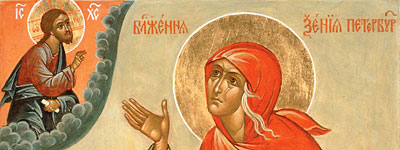

| Previous day | Next day |
| Old Style
January 24
|
Tuesday |
New Style
February 6
|
| 36th Week after Pentecost. Tone 2. | No fast.
|
![]() St. Xenia of Rome and her two female slaves (ca. 457).
St. Xenia of Rome and her two female slaves (ca. 457). ![]() St. Xenia of St. Petersburg, fool-for-Christ (19th c.).
St. Xenia of St. Petersburg, fool-for-Christ (19th c.).
Martyrs Babylas of Sicily and his two disciples Timothy and Agapius (3rd c.). St. Macedonius, hermit of Mt. Silpius, near Antioch (ca. 420). Translation of the relics of Monk-martyr Anastasius the Persian (7th c.). St. Gerasim, bishop of Perm (ca. 1449). Martyr John of Kazan (1529). St. Dionysius of Olympus and Mt. Athos (1541). St. Sophia, first abbess of Shamordino Convent (1888). Blessed Valentina (Sulkovskaya) of Minsk (1966).
Martyrs Paul, Pausirius, and Theodotian, of Egypt (3rd c.). St. Felician, bishop of Foligno in Italy (254). St. Philo, bishop of Carpasia on Cyprus (5th c.). St. Lupicinus of Lipidiaco (Gaul) (500). St. Zosimas of Cilicia, bishop of Babylon in Egypt (6th c.). St. Neophytus the Recluse, of Cyprus (1214).
Repose of Bishop Nektary (Kontzevitch) of Seattle (1983).
Thoughts for Each Day of the Year
According to the Daily Church Readings from the Word of God
By St. Theophan the Recluse

Tuesday. [Eph. 2:19-3:7; Mark 11:11-23]
The fig tree covered with leaves was splendid in appearance, but was not honoured with approval from the Lord because there was no fruit on it, and there was no fruit because there was no inner fruit-bearing power. How many such fig trees there are in the moral sense! In appearance all is proper, but on the inside there is nothing. They are orderly, honourable, and fulfil all that is Christian, but they do not have the spirit of life in Christ Jesus; that is why they do not have living fruit. And what is in them only seems to be fruit, but is not. In what lies the spirit of life in Christ Jesus? To this we say: one part in this is from the Lord, and the other from us. What is from the Lord essentially is a fruit-bearing spiritual power; while what comes from us is just the receiver of this power. Concern yourself more with the latter. The root of this is the feeling that you are perishing, and that if it were not for the Lord, you would perish. From this you will have a heart that is broken and humbled, in everything you do, throughout your life. Further, since the future is unknown, there are many enemies, and you can stumble every moment, fear and trembling accompany salvation, along with the unceasing cry: “O Thou Who knoweth all things, save me.” Woe to him also who rests on something other than the Lord; woe to him who has worked for something other than the Lord! Ask yourself, you who labour in deeds which are considered God-pleasing, for whom are you working? If your conscience boldly answers: only for the Lord—it is good; but if not, you are building a house upon the sand. Here are several indications of a fertile inner spirit. You can understand many other things according to this.
Articles
 St. Xenia of PetersburgSt. Xenia of Petersburg |
 St. Macedonius the Hermit of SyriaSaint Macedonius, a Syrian hermit, lived during the end of the fourth century and the beginning of the fifth. |
 Martyrs Paul, Pausirius, and Theodotian, of EgyptThe Holy Martyrs Paul, Pausirius, and Theodotion lived in Egypt during the third century. |
 St. Philon, Bishop of Kolpasteia, CreteSaint Philon, Bishop of Kolpasteia (Crete) He died peacefully in the fifth century. |














